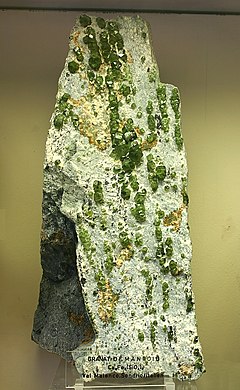Demantoid
| Demantoid | |
|---|---|

Demantoid
|
|
| General | |
| Category | Mineral |
|
Formula (repeating unit) |
Ca3Fe2Si3O12 |
| Crystal system | cubic |
| Identification | |
| Color | light to deep green |
| Mohs scale hardness | 6.5–7.0 |
| Luster | adamantine |
| Specific gravity | 3.84 |
| Optical properties | Single Refractive |
| Refractive index | 1.880–1.889 |
| Pleochroism | none |
| Dispersion | .057 |
| Common impurities | Cr |
Demantoid is the green gemstone variety of the mineral andradite, a member of the garnet group of minerals. Andradite is a calcium- and iron-rich garnet. The chemical formula is Ca3Fe2(SiO4)3 with chromium substitution as the cause of the demantoid green color. Ferric iron is the cause of the yellow in the stone.
It has the misnomers olivine, and Uralian emerald.
In approximately 2003, reports began to circulate in the trade that some Russian demantoid garnets were being routinely subjected to heat treatment in order to enhance their color. Such treatment is believed to be performed at relatively low temperatures and is thought not to be detectable by gemological testing.
Although garnets have been known since ancient times, the demantoid variety was not discovered until 1868 in Russia's western central Ural Mountains. The find was an alluvial deposit about 110 kilometers from Ekaterinburg, north by northwest along the Bobrovka River, near the village of Elizavetinskoye. Miners were immediately stunned by the highly refractive nature of the gem material, which is atypical for garnet. They began comparing it to diamond and referred to it as "demantoid", from the French demant, meaning diamond. The reason is obvious, with its high brilliance and dispersion.
A second find was made 75 km. to the south of Ekaterinburg, on the Chusovaya and Chrisolitka Rivers southwest of the village of Poldnevaya. Deposits are also found underground up to 3 meters deep in the demantoid placier. In all, there are five deposits of demantoid in this area. Possessing an unusual green color and a dispersion greater than that of diamond, it quickly became a treasured and expensive gemstone. From the time of the demantoids find until about 1919, they were popular in Russia as the famous Peter Carl Fabergé made jewelry with them. In austere Communist Russia, these gems went out of style.
More stones were found in the Bobrovka River in the 1970s and 1980s. Around 1999, very limited production occurred in the central Ural Mountains. Many of the stones found then are for sale today. Mining takes place along the rivers today, but some mining is still done secretively.
...
Wikipedia
